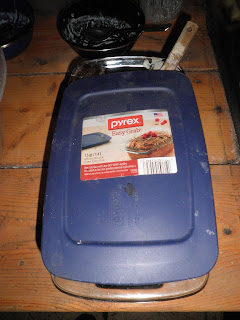How to make a sourdough starter
In years gone by experienced pioneers in the North were known as 'sourdoughs'. This was because of the sourdough starters they kept with them for making their bread rise. Yeast just didn't work as well. Some would hang their starter in a bag around their necks and even sleep with it so it wouldn't freeze.
Your sourdough starter will give you a base for making bread and it'll keep going forever - if you look after it.
How to make your starter
The Alaskan recipe we picked up to make a starter was this. Mix some flour into the (cooled) water potatoes have been boiled in to make a paste. Add a little sugar, then keep the mixture nice and warm. You know when your starter has come alive because you'll see bubbles in the paste and it develops a spongy texture. There will also be a sour, yeasty smell coming from it.
Depending on how warm you keep the mix and how active the yeasts are you should see it come alive after 24-72 hours.
Feed your starter
Once the starter has come to life you need to feed him with a little flour each day for a few days until you have about two cupfuls of starter. You need to add a water as well, don't let him dry out or he will go to sleep. Not a disaster, just add some more water and he'll revive again.
You must keep your starter warm and regularly fed. Don't ever let him freeze otherwise you'll kill him and have to start all over again.
You need to keep your starter in a non-metallic container with a loose fitting lid (not airtight, that'll also finish him off). Don't use a metal spoon to mix him or spoon him out, he'll react badly to metal. We use a Pyrex bowl with a loose-fitting lid that we keep above our woodstove and a wooden mixing stick that stays in his dish to make sure the lid never goes on too tight.
The miraculous reincarnation
If you need to leave your starter for an extended period you should dry him out completely. Spoon some small dollops of starter on to a flat surface and dry them out slowly and completely (usually takes 24-48 hours). Once you have dry flakes, store them in an airtight container.
As long as the flakes stay dry you can bring him back to life just by adding water, flour and a little sugar. It should only take 24 hours or so to revive him. We've been away for 6 months at a time and our starter has revived just fine.
Why bother? Well, the flavour of a sourdough starter improves with age, so they say. We've only had ours for about 4-5 years so far but the flavour does seem to get better.
Now you've got your sourdough starter you can make all sorts of delicious sourdough recipes. An informative and quirky book on all things sourdough is Ruth Allman's 'Alaska Sourdough' (Alaska Northwest Books). There are plenty of recipes as well as lots of anecdotes.
Your sourdough starter will give you a base for making bread and it'll keep going forever - if you look after it.
How to make your starter
The Alaskan recipe we picked up to make a starter was this. Mix some flour into the (cooled) water potatoes have been boiled in to make a paste. Add a little sugar, then keep the mixture nice and warm. You know when your starter has come alive because you'll see bubbles in the paste and it develops a spongy texture. There will also be a sour, yeasty smell coming from it.
Depending on how warm you keep the mix and how active the yeasts are you should see it come alive after 24-72 hours.
Feed your starter
Once the starter has come to life you need to feed him with a little flour each day for a few days until you have about two cupfuls of starter. You need to add a water as well, don't let him dry out or he will go to sleep. Not a disaster, just add some more water and he'll revive again.
 |
| Our starter, bubbling contentedly |
 |
| Our container (with loose-fitting lid) |
 |
| Our starter above the woodstove |
If you need to leave your starter for an extended period you should dry him out completely. Spoon some small dollops of starter on to a flat surface and dry them out slowly and completely (usually takes 24-48 hours). Once you have dry flakes, store them in an airtight container.
As long as the flakes stay dry you can bring him back to life just by adding water, flour and a little sugar. It should only take 24 hours or so to revive him. We've been away for 6 months at a time and our starter has revived just fine.
Why bother? Well, the flavour of a sourdough starter improves with age, so they say. We've only had ours for about 4-5 years so far but the flavour does seem to get better.
Now you've got your sourdough starter you can make all sorts of delicious sourdough recipes. An informative and quirky book on all things sourdough is Ruth Allman's 'Alaska Sourdough' (Alaska Northwest Books). There are plenty of recipes as well as lots of anecdotes.



Comments
Post a Comment